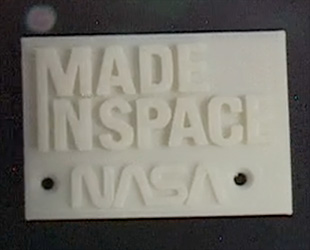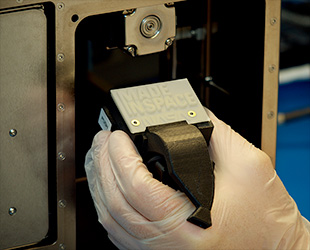Nov. 25, 2014 — The International Space Station, as its name implies, was assembled from parts that were made around the world. For the first time in its history however, the orbiting outpost has gained a part like no other.
It was made in space.
At 4:28 p.m. EST (0928 GMT) Monday (Nov. 24), the first 3D printer designed to be operated in space successfully manufactured its first part on board the space station. The print marked the first time hardware has been additively produced off-planet, rather than launching it from Earth.
The history-making part was the faceplate for the printer's own extruder printhead. Leaving absolutely no question of where it was made, or who made it, the faceplate included its own "Made In Space" label.
"This 'first print' serves to demonstrate the potential of the technology to produce replacement parts on demand if a critical component fails in space," said Jason Dunn, chief technical officer for Made In Space, the aptly-named small California-based company behind the 3D printer.

The 3D printed faceplate includes Made In Space, Inc. and NASA logos. It will be installed on the printer's extruder printhead. (MIS) |
The 1.5-by-2-inch (40-by-60-millimeter) faceplate was the first product of the 3D Printing in Zero-Gravity Experiment, a technology demonstration being run by NASA's Marshall Space Flight Center in Alabama and Made In Space. The printer was delivered to the space station in September.
NASA astronaut Butch Wilmore installed the microwave-size device in the U.S. Destiny lab's microgravity science glovebox on Nov. 17.
"The results of this experiment will serve as a stepping stone for significant future capabilities that will... change exploration mission architectures for the better," said Mike Snyder, director of research and development for Made In Space and the principal investigator for the space station's printer. "Manufacturing components on demand will yield more efficient and less Earth-dependent space programs in the near future."
The initial phase of the 3D printing experiment will see the production of a variety of test coupons — parts and tools printed in order to validate the design and construction of the printer itself. Made In Space will print the same parts on their identical ground unit in order to provide a group of control examples. The space-made prints will be returned to Earth in order for the ground- and microgravity parts to be compared.
Once back on Earth, the test prints will be used to provide data on their tensile strength, torque and flexibility, among other factors. This information will enable Made In Space to make adjustments to a second 3D printer scheduled for delivery to the space station next year.

The 'First Print' is a part of the printer itself. The faceplate holds internal wiring in place within the 3D printer's extruder. (MIS) |
This second printer will be available for use by NASA and the station's crew, but also by commercial businesses and individuals on Earth to create on-demand hardware, such as small satellites.
"The [space station] has provided us with an ideal lab for demonstrating this game-changing technology that will not only benefit the station, but will also enable sustainable deep space missions," said Niki Werkheiser, the project's manager at the Marshall Space Flight Center.
NASA and Made In Space plan additional experiments to further test aspects of additive manufacturing onboard the space station.
"In 1957, Sputnik became the first man-made object in space and, 12 years later, that led to humans setting foot on the moon," said Aaron Kemmer, chief executive officer of Made In Space, Inc. "Now in 2014, we've taken another significant step forward, we've started operating a machine that will lead us to continual manufacturing in space."
"Decades from now, people will look back to this event," he said. "It will be seen as the moment when the paradigm of how we get hardware to space changed."
